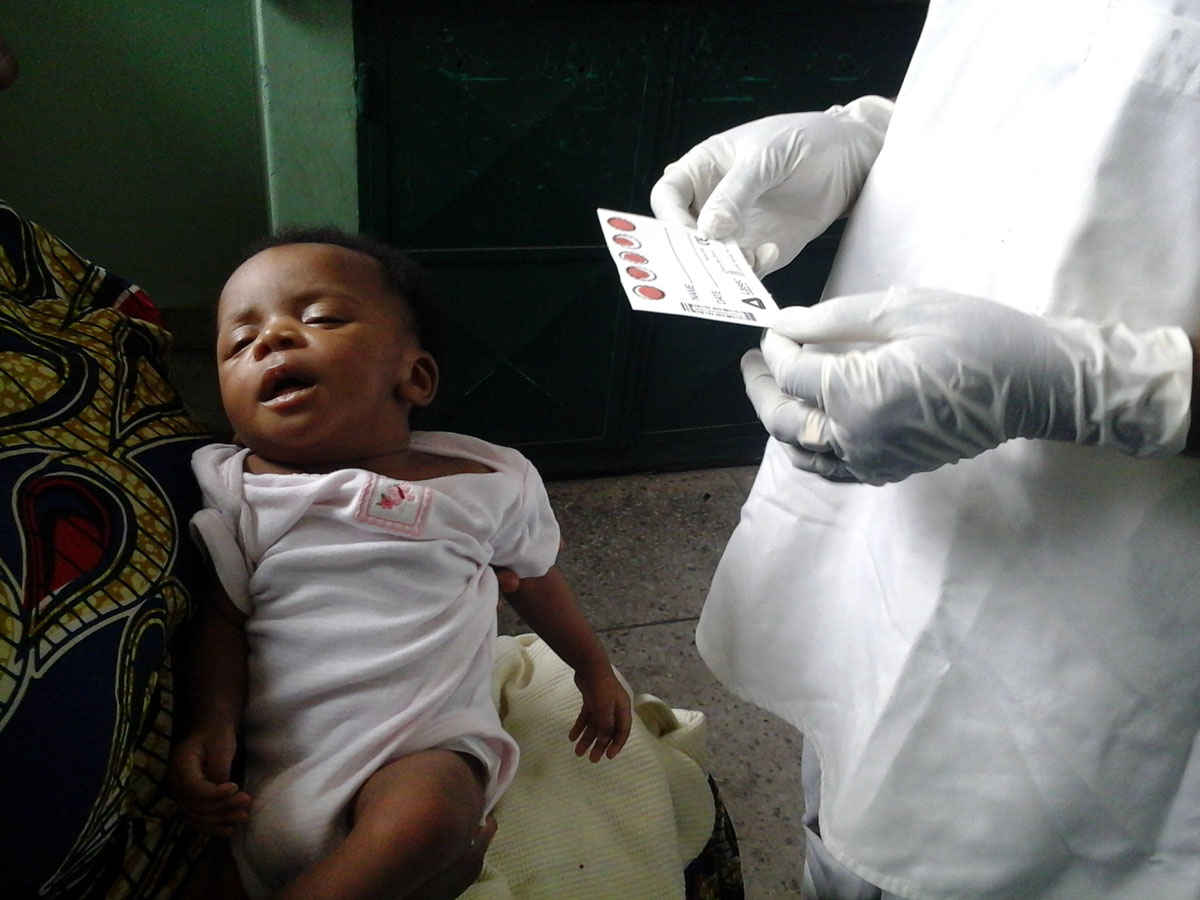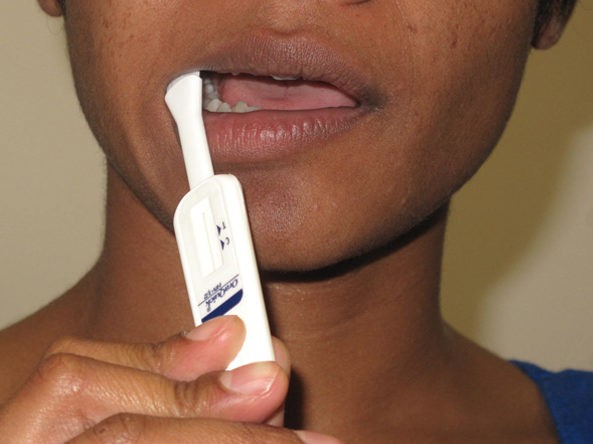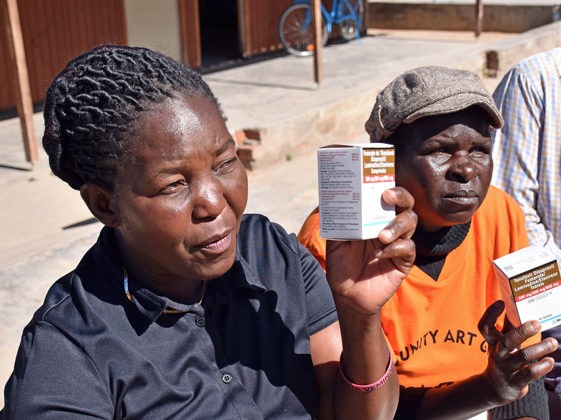Article and Study Summary
Effect of point-of-care early infant diagnosis on antiretroviral therapy initiation and retention of patients: A cluster-randomised trial.
Published in:
AIDS. 2018. Published online ahead of print.
doi: 10.1097/QAD.0000000000001846
Authors:
Jani IV, Meggi B, Loquiha O, et al.
Summary:
This article reports on the results of a cluster-randomized controlled trial that evaluated the effect of point-of-care (POC) early infant HIV testing on rates of antiretroviral therapy (ART) initiation and retention in care. Sixteen public primary health care clinics in Mozambique were randomized to either use POC technology for testing HIV-exposed infants accessing early infant HIV testing services, or to the standard of care (SOC), in which samples were sent to reference laboratories for processing. HIV-positive infants in the POC study arm were significantly more likely to initiate ART within 60 days and to be retained in care 90 days after ART initiation. POC testing also substantially reduced the turnaround time from sample collection to receipt of results by caregivers, and was associated with more rapid ART initiation. Same-day availability of test results also reduced loss to follow-up prior to treatment initiation. POC technology for early infant diagnosis can improve performance across the treatment cascade for HIV-exposed infants in settings where laboratory services are limited, making it a promising tool to reduce morbidity and mortality in this population.
Download full synopsis in English here or read below.
Full synopsis is also available in French and Portuguese.
Discussion Questions:
- How could the results presented in this article inform early infant diagnosis strategies in the programs that you work with?
- What programmatic challenges do you foresee with implementing point-of-care technology for early infant diagnosis based on this study? Do you have any best practices to share?
Please share your thoughts and experiences with us in the comments section below.
Full Synopsis:
Study Summary
This cluster-randomized controlled trial evaluated the effect of point-of-care (POC) early infant HIV testing on rates of antiretroviral therapy (ART) initiation and retention in care among HIV-positive infants who presented for early infant diagnosis at health facilities in Mozambique.
Study Setting
- Public primary health care clinics in urban, peri-urban, and rural Mozambique.
Methods
- Health facilities were eligible for inclusion if they offered routine early infant diagnosis and ART services, had at least one HIV-positive infant per month, and were less than 100 kilometers from the provincial capital city.
- HIV-exposed infants were included in the study if they presented for early infant HIVtesting following referral from maternity wards, immunization clinics, nutrition consultation, or well-child programs.
- Infants were excluded if they had a previous HIV-positive test result, were already on ART, were older than 18 months, or had serious medical conditions that could be exacerbated by testing.
- Sixteen health facilities were randomly selected among 48 eligible facilities, and randomized (1:1) into either the POC intervention or the standard of care (SOC) study arm.
- At the POC arm sites, nurses were trained on the use of the Alere q POC device for nucleic acid-based early infant diagnosis, using heel- or toe-prick capillary blood samples. Test run time was approximately 50 minutes, and caregivers were advised to wait for the results.
- The SOC arm sites used existing reference laboratory testing for early infant HIVtesting. Capillary blood samples were collected on dried blood spot cards and sent to central laboratories for testing, and results were returned to sites electronically using mobile technology.
- In both arms, confirmatory testing was performed using the same method as the initial test.
- In both arms, nurses were encouraged to refer infants with HIV-positive results for ARTinitiation on the same day as result availability, and subsequent clinical care was provided as per national guidelines, with minimal supervision from study staff.
- The primary outcomes were: proportion of HIV-positive infants initiating ART within 60 days of sample collection; and proportion of HIV-positive infants who initiated ARTthat were retained in care at 90 days of follow-up. Patients were considered retained in care if they had visited the health facility within the previous 30 days.
- Secondary outcomes were: median infant age when results were received by caregivers; median number of days between specimen collection and results received by caregivers; median age at ART initiation; and median number of days between specimen collection and ART initiation.
- Data were collected from routine early infant diagnosis clinic registers, patient files, and the national early infant diagnosis database.
- Statistical analyses used generalized estimating equations to obtain estimates of relative risk (RR), adjusted for age, sex, and within-cluster correlation.
Study Population and Follow-up
- From September 2015 to October 2016, 2,034 infants in the POC arm and 1,876 infants in the SOC arm were included in the analysis. Of these, 175 infants in the POCarm and 102 infants in the SOC arm had a positive HIV test result.
- Most mothers (92.0%) received ART, and 92.6% of infants received nevirapine prophylaxis.
- Infants in the POC arm were older at sample collection (median 40 days, interquartile range [IQR] 31–96) than those in the SOC arm (median 33 days, IQR 31–48; p<0.001).
- There were no significant differences in gender, maternal and child treatment regimens, and proportion of HIV-positive infants between study arms.
- Confirmatory testing of infants with a positive test result was more frequent in the POCarm (54.6%) compared to the SOC arm (13.9%).
- When positive HIV test results were available at the health facility, 99.4% (174/175) of caregivers in the POC arm received the results compared to 62.7% (64/102) in the SOCarm.
- Among those HIV-positive infants who received their results, 94.3% initiated ART in the POC arm compared to 76.6% in the SOC arm.
- Time between results being received by caregivers and ART initiation was similar in the POC arm (median 0 days, IQR 0–1) and the SOC arm (median 0 days, IQR 0–0; p=0.768).
Primary Outcomes
- More HIV-positive infants initiated ART within 60 days of sample collection in the POC arm compared to in the SOC arm (89.7% vs. 12.8%; adjusted RR [RRadj] 7.34, 95% confidence interval [CI] 4.7–11.5).
- Retention in care 90 days after ART initiation was higher in the POC arm compared to the SOC arm (61.6% vs. 42.9%; RRadj 1.40, 95% CI 1.1–1.9).
Secondary Outcomes
- Median age at the time test results were received was lower in the POC arm (41 days, IQR 31–98) compared to the SOC arm (172 days, IQR 123–237; p<0.001).
- Median time from sample collection to test results being received by the caregiver was 0 days (IQR 0–0) in the POC arm and 125 days (IQR 84–185) in the SOC arm (p<0.001).
- Median age at ART initiation was 127 days (IQR 58–268) in the POC arm and 202 days (IQR 153–278) in the SOC arm (p<0.001).
- Median time from sample collection to ART initiation was 0 days (IQR 0–1) in the POC arm and 127 days (IQR 44–154) in the SOC arm (p<0.001).
Critical Analysis
This cluster-randomized trial demonstrated that the use of POC technology for early infant HIV testing significantly increased the proportion of HIV-positive infants initiated on ARTat 60 days and was associated with greater retention in care 90 days after ART initiation. As expected, POC technology substantially reduced the turnaround time for test results received by caregivers, which contributed to HIV-positive infants initiating ART at a younger age, as most were initiated on the same day results were received.
The following points should be considered when interpreting the study findings:
- In the SOC arm, median turnaround time for test results was approximately four months, which is notably longer than the World Health Organization (WHO) recommendation of four weeks or less,(1) and only 64 of the 102 positive results were received by caregivers, suggesting significant loss to follow-up after sample collection. Therefore, the relative benefits of POC testing seen in this study may not be generalizable to other contexts with shorter laboratory turnaround times and stronger active tracking measures after a positive test result.
- In this study, turnaround time was defined as time between sample collection and receipt of results by caregivers; however, it would also be important to know how long it took for the results to reach the health facility in order to better understand the delays in the SOC arm.
- The median turnaround time for receipt of results by caregivers for HIV-positive infants was higher (152.5 days) than the median turnaround time for all test results (125 days), which suggests there was no active outreach to caregivers following a positive test result.
- While analyses adjusted for clustering by health facility, the study did not evaluate specific health facility characteristics that may contribute to performance along the cascade, such as patient volume or distance to local laboratories.
- The data collected were limited to routine programmatic data and therefore did not include reasons infants on ART were lost to follow-up. Given that infants in the SOCarm were significantly older when they initiated ART than in the POC arm, it is possible that the lower retention seen in the SOC arm was in part due to increased mortality from late ART initiation.
- Overall retention 90 days after ART initiation was low, with less than two-thirds retained in both groups, suggesting a need for further interventions to improve retention in care.
- This study did not evaluate clinical outcomes; therefore, further research is needed to assess the impact of POC early infant HIV testing on morbidity and mortality in infants living with HIV.
- This study only included infants who returned for early infant HIV testing, rather than all HIV-exposed infants at participating health facilities. POC HIV testing at birth is currently being evaluated, and is expected to further improve retention in the HIVtesting and treatment cascade if adopted.(2)
Implications
This cluster-randomized trial demonstrated that the use of POC technology for early infant HIV testing in HIV-exposed infants improved rates of ART initiation and retention in care in real-world clinical settings. Additionally, infants diagnosed with HIV using POCtechnology started ART earlier, largely due to a substantial reduction in the time it took for caregivers to receive test results. Expanding access to POC HIV testing could be advantageous in contexts where laboratory services are limited and results cannot be received within four weeks as recommended by the WHO.(1) The use of POC technology can also improve the treatment cascade by providing results to caregivers on the same day, thereby reducing the numbers lost to follow-up before results are available. As programs work toward timely early infant diagnosis and ART initiation, the use of POC technology should be considered to improve outcomes in settings without effective laboratory services.
References
- World Health Organization. Recommendations on the diagnosis of HIV infection in infants and children. Geneva, 2010. http://www.who.int/hiv/pub/paediatric/diagnosis/en/
- Jean-Philippe P, Spiegel H, Gnanashanmugam D, et al. HIV Birth testing and linkage to care for HIV-infected infants. AIDS. 2017;31(13):1797–1807








